Vue + Spring Boot 项目实战笔记
Posted a1oyss
tags:
篇首语:本文由小常识网(cha138.com)小编为大家整理,主要介绍了Vue + Spring Boot 项目实战笔记相关的知识,希望对你有一定的参考价值。
Vue + Spring Boot 项目实战(二)笔记
前端页面开发
设置反向代理
原教程代码:
import Vue from \'vue\'
import App from \'./App\'
import router from \'./router\'
// 设置反向代理,前端请求默认发送到 http://localhost:8443/api
var axios = require(\'axios\')
axios.defaults.baseURL = \'http://localhost:8443/api\'
// 全局注册,之后可在其他组件中通过 this.$axios 发送数据
Vue.prototype.$axios = axios
Vue.config.productionTip = false
/* eslint-disable no-new */
new Vue({
el: \'#app\',
router,
components: { App },
template: \'<App/>\'
})
新版代码:
import Vue from "vue";
import router from \'./router\'
import App from "./App";
import axios from "axios"
axios.defaults.baseURL=\'http://localhost:8443/api\'
Vue.prototype.$axios=axios
Vue.config.productionTip=false
new Vue({
el:\'#app\',
router,
render: h => h(App)
})
首先是要通过npm安装axios,然后就可以直接import
Vue.prototype.$axios=axios
Vue.prototype.$axios=axios这么写的原因是为了让所有组件都可以使用axios,但又不会污染全局作用域,以$开头则只是规范,为了与组件中定义的数据、方法、计算属性区分开。
例如:
Vue.prototype.appName = \'My App\'
new Vue({
data: {
// 啊哦,`appName` *也*是一个我们定义的实例 property 名!《Spring Boot+Vue全栈开发实战》读书笔记
写在前面
- 嗯,回家处理一些事,所以离职了,之前的公司用开源技术封装了一套自己的低代码平台,所以之前学的spring Boot之类的东西都忘了很多,蹭回家的闲暇时间复习下。
- 笔记整体以 Spring Boot+Vue全栈开发实战一书为方向,中间穿插一些其他视频(原书作者的视频)的知识点。
- 嗯,生活加油,这段时间好好休养,笔记在更新中…整装待发 ^ _ ^,加油生活…
我年青时以为金钱至上,而今年事已迈,发现果真如此 —王尔德
使用XML配置搭建SSM项目
代码详见:https://github.com/LIRUILONGS/SSM-XML.git
新建一个maven工程,构造SSM目录结构
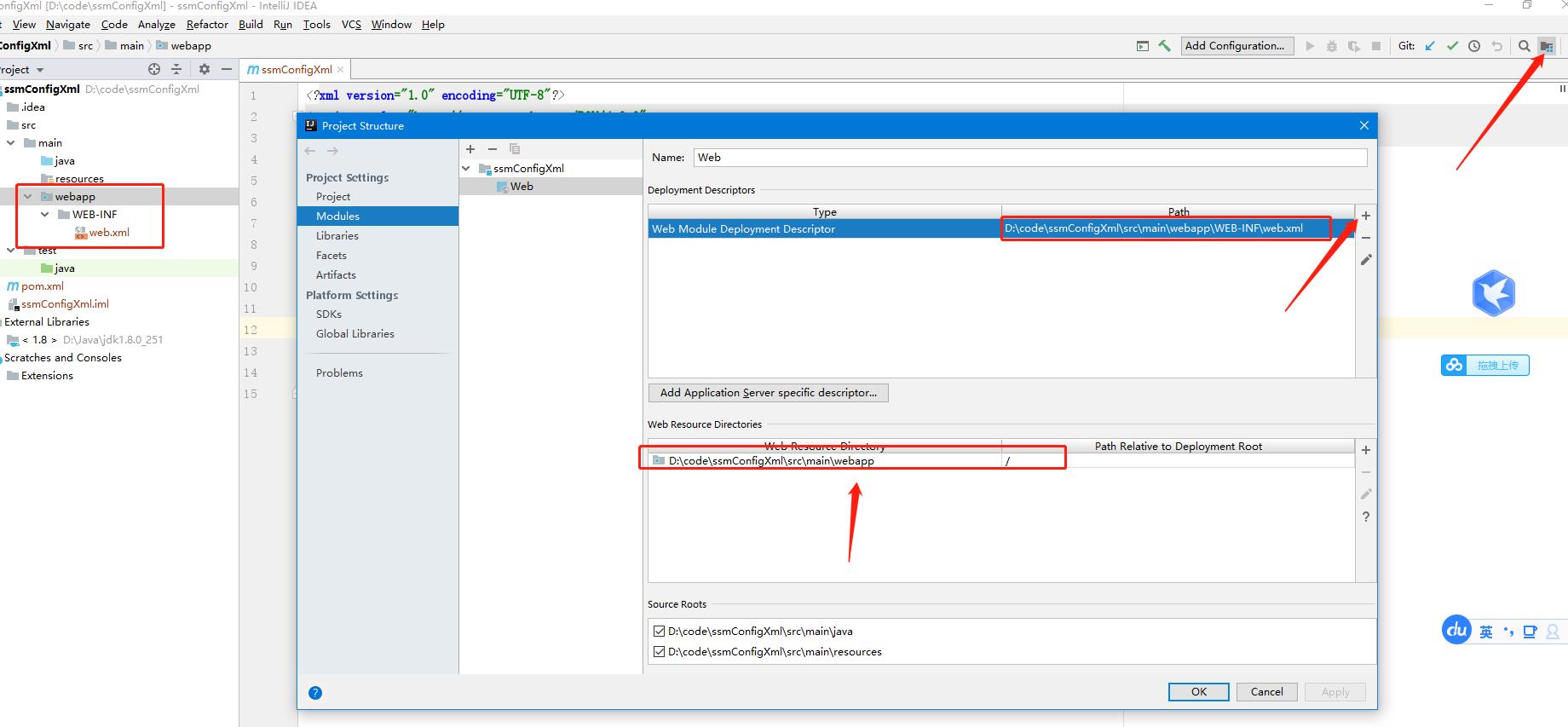
添加依赖,构建配置文件
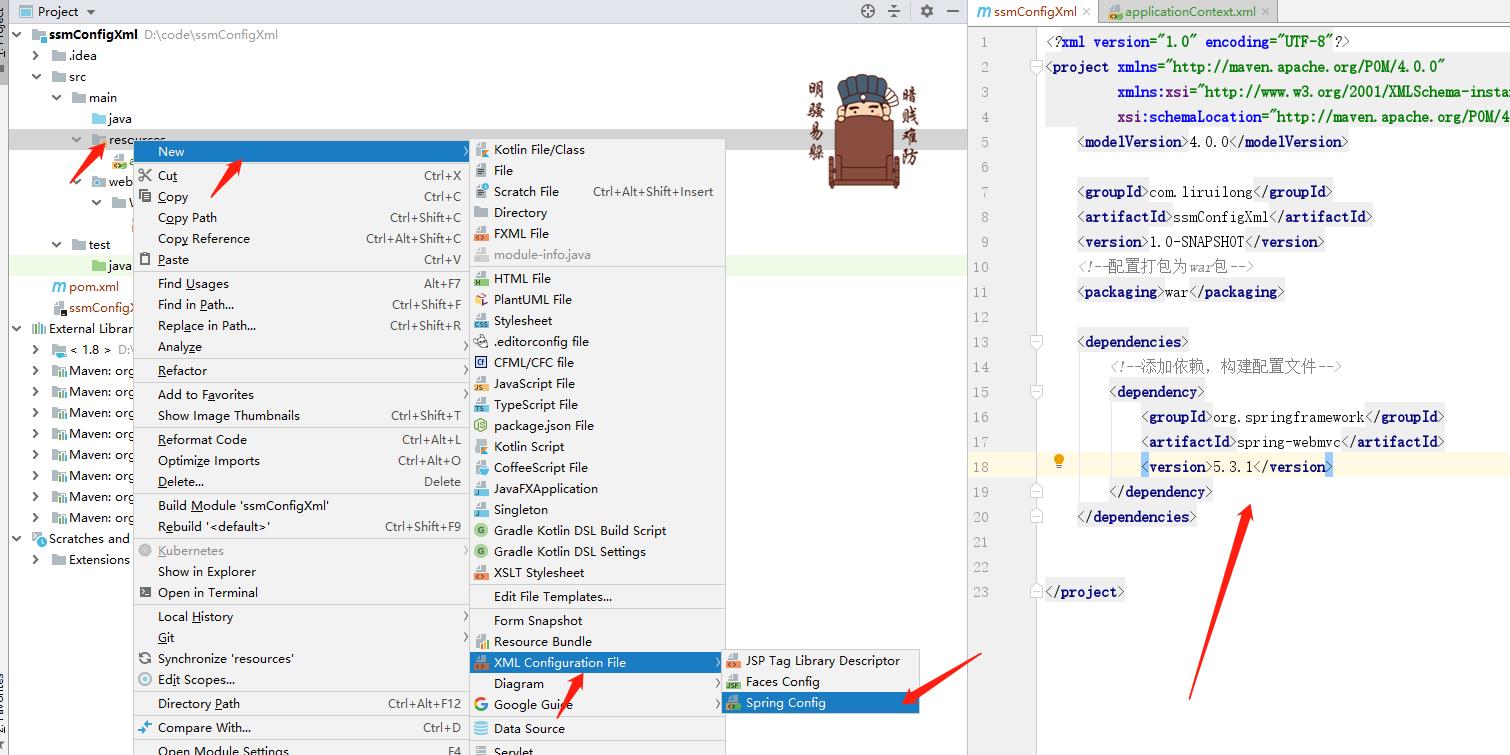
SpringMVC是Spring的子容器,所以SpringMVC子容器可以访问Spring父容器,反之则不行。所以Spring的配置文件扫描除了Controller的bean,SpringMVC扫描controller的东西。
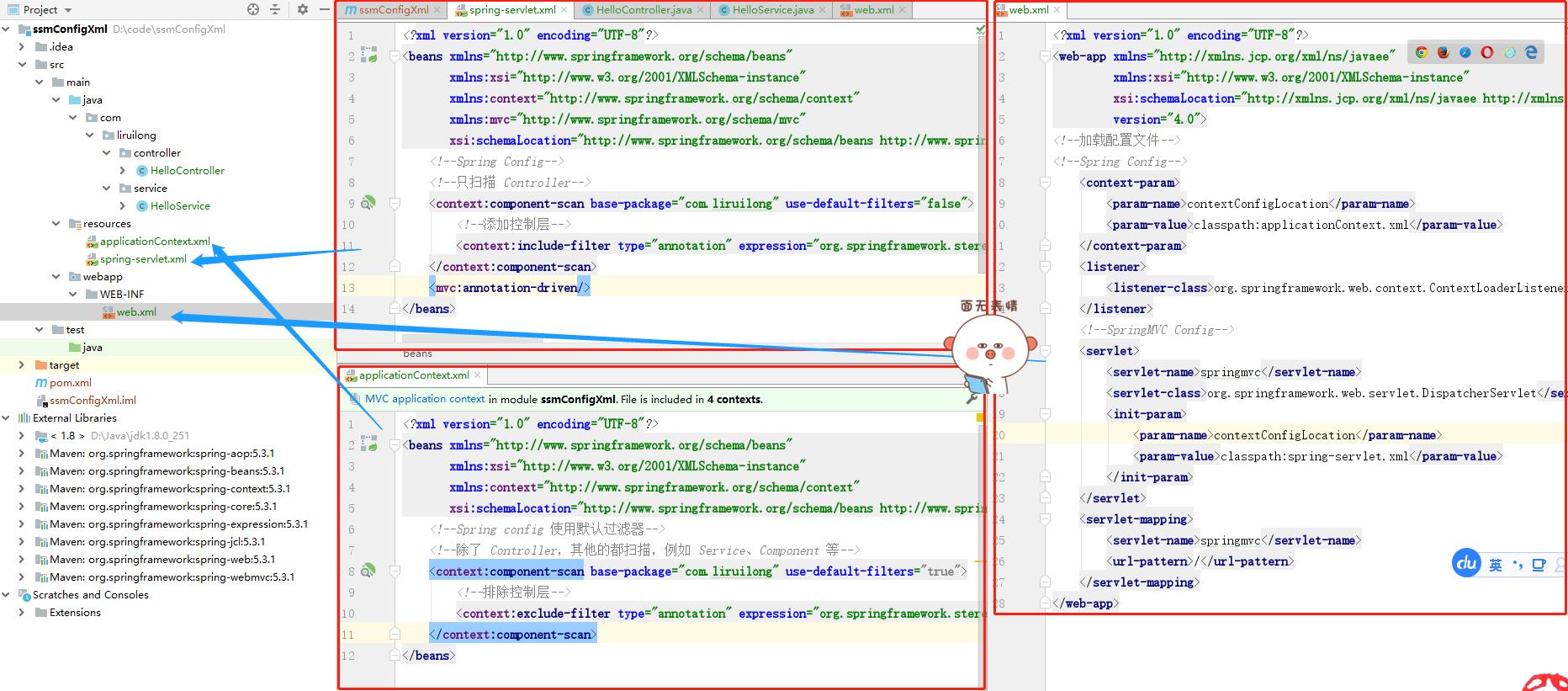
使用 Java配置类搭建SSM项目
代码详见:https://github.com/LIRUILONGS/SSM-java.git
- @Configuration 注解表示这是一个配置类,在我们这里,这个配置的作用类似于 applicationContext.xml
- @ComponentScan 注解表示配置包扫描,里边的属性和 xml 配置中的属性都是一一对应的,useDefaultFilters 表示使用默认的过滤器,然后又除去 Controller 注解,即在 Spring 容器中扫描除了 Controller 之外的其他所有 Bean 。
- 使用 Java 代码去代替 web.xml 文件,这里会用到 WebApplicationInitializer ,WebInit 的作用类似于 web.xml,这个类需要实现 WebApplicationInitializer 接口,并实现接口中的方法,当项目启动时,onStartup 方法会被自动执行,我们可以在这个方法中做一些项目初始化操作,例如加载 SpringMVC 容器,添加过滤器,添加 Listener、添加 Servlet 等。具体定义如下:

注意:
由于我们在 WebInit 中只是添加了 SpringMVC 的配置,这样项目在启动时只会去加载 SpringMVC 容器,而不会去加载 Spring 容器,如果一定要加载 Spring 容器,需要我们修改 SpringMVC 的配置,在 SpringMVC 配置的包扫描中也去扫描 @Configuration 注解,进而加载 Spring 容器,还有一种方案可以解决这个问题,就是直接在项目中舍弃 Spring 配置,直接将所有配置放到 SpringMVC 的配置中来完成,这个在 SSM 整合时是没有问题的,在实际开发中,较多采用第二种方案,第二种方案,SpringMVC 的配置如下:
-
静态资源过滤:重写 addResourceHandlers 方法,在这个方法中配置静态资源过滤,这里我将静态资源放在 resources 目录下,所以资源位置是 classpath:/ ,当然,资源也可以放在 webapp 目录下,此时只需要修改配置中的资源位置即可。如果采用 Java 来配置 SSM 环境,一般来说,可以不必使用 webapp 目录,除非要使用 JSP 做页面模板,否则可以忽略 webapp 目录。
-
视图解析器
<bean class="org.springframework.web.servlet.view.InternalResourceViewResolver">
<property name="prefix" value="/WEB-INF/jsp/"/>
<property name="suffix" value=".jsp"/>
</bean>
@Configuration
@ComponentScan(basePackages = "org.javaboy")
public class SpringMVCConfig extends WebMvcConfigurationSupport {
@Override
protected void configureViewResolvers(ViewResolverRegistry registry) {
registry.jsp("/jsp/", ".jsp");
}
}
- 路径映射:控制器的作用仅仅只是一个跳转,就像上面小节中的控制器,里边没有任何业务逻辑,像这种情况,可以不用定义方法,可以直接通过路径映射来实现页面访问。如果在 XML 中配置路径映射
<mvc:view-controller path="/hello" view-name="hello" status-code="200"/>
这行配置,表示如果用户访问 /hello 这个路径,则直接将名为 hello 的视图返回给用户,并且响应码为 200,这个配置就可以替代 Controller 中的方法。
@Configuration
@ComponentScan(basePackages = "org.javaboy")
public class SpringMVCConfig extends WebMvcConfigurationSupport {
@Override
protected void addViewControllers(ViewControllerRegistry registry) {
registry.addViewController("/hello3").setViewName("hello");
}
}
JSON 配置SpringMVC 可以接收JSON 参数,也可以返回 JSON 参数,这一切依赖于 HttpMessageConverter。
HttpMessageConverter 可以将一个 JSON 字符串转为 对象,也可以将一个对象转为 JSON 字符串,实际上它的底层还是依赖于具体的 JSON 库。
所有的 JSON 库要在 SpringMVC 中自动返回或者接收 JSON,都必须提供和自己相关的 HttpMessageConverter 。
SpringMVC 中,默认提供了 Jackson 和 gson 的 HttpMessageConverter ,分别是:MappingJackson2HttpMessageConverter 和 GsonHttpMessageConverter 。
正因为如此,我们在 SpringMVC 中,如果要使用 JSON ,对于 jackson 和 gson 我们只需要添加依赖,加完依赖就可以直接使用了。具体的配置是在 AllEncompassingFormHttpMessageConverter 类中完成的。
如果开发者使用了 fastjson,那么默认情况下,SpringMVC 并没有提供 fastjson 的 HttpMessageConverter ,这个需要我们自己提供,如果是在 XML 配置中,fastjson 除了加依赖,还要显式配置 HttpMessageConverter,如下:
<mvc:annotation-driven>
<mvc:message-converters>
<bean class="com.alibaba.fastjson.support.spring.FastJsonHttpMessageConverter">
</bean>
</mvc:message-converters>
</mvc:annotation-driven>
第1章Spring Boot入门
- 提供一个快速的Spring项目搭建渠道
- 开箱即用,很少的Spring 配置就能运行一个Java EE项目。
- 提供了生产级的服务监控方案。
- 内嵌服务器,可以快速部署。
- 提供了一系列非功能性的通用配置。
- 纯Java配置,没有代码生成,也不需要XML配置。
第2章 Spring Boot基础配置
工程创建的三种方式:
- 在线创建
- 通过 IDE 来创建(IntelliJ IDEA、STS)
- 通过改造一个普通的 Maven 工程来实现
2.1不使用spring-boot-starter-parent
spring-boot-starter-parent主要提供了如下默认配置:
- Java版本默认使用1.8.编码格式
- 默认使用UTF-8.
- 提供Dependency Management进行项目依赖的版本管理。
- 默认的资源过滤与插件配置
2.2 @Spring BootApplication.
@Target(ElementType.TYPE)
@Retention(RetentionPolicy.RUNTIME)
@Documented
@Inherited
@SpringBootConfiguration
@EnableAutoConfiguration
@ComponentScan(excludeFilters = { @Filter(type = FilterType.CUSTOM, classes = TypeExcludeFilter.class),
@Filter(type = FilterType.CUSTOM, classes = AutoConfigurationExcludeFilter.class) })
public @interface SpringBootApplication {
....
@Spring BootApplication 是一个组合注解:
- @SpringBootConfiguration原来就是一个@Configuration,所以@Spring BootConfiguration的功能就是表明这是一个配置类。开发者可以在这个类中配置Bean。从这个角度来讲,这个类所扮演的角色有点类似于Spring中applicationContext.xml文件的角色。
- 第二个注解@EnableAutoConfiguration表示开启自动化配置。 Spring Boot中的自动化配置是非侵入式的,在任意时刻,开发者都可以使用自定义配置代替自动化配置中的某一个配置。
- 第三个注解@ComponentScan完成包扫描,也是Spring中的功能。由于@ComponentScan注解默认扫描的类都位于当前类所在包的下面,因此建议在实际项目开发中把项目启动类放在根包。
2.3定制banner
- Spring Boot项目在启动时会打印一个banne
- 定制网站:http://patorjk.com/software/taag
@SpringBootApplication
public class SpringBootDemoApplication {
public static void main(String[] args) {
SpringApplicationBuilder builder = new SpringApplicationBuilder(SpringBootDemoApplication.class);
builder.bannerMode(Banner.Mode.OFF).run(args);
}
}
2.4 Web容器配置
2.4.1 Tomcat配置
##配置了Web容器的端口号。
server.port=8081
##配置了当项目出错时跳转去的页面。
server.error.path=/error
##配置了session失效时间, 30m表示30分钟,如果不写单位,默认单位是秒。由于Tomcat中配置session过期时间以分钟为单位,因此这里单位如果是秒的话,该时间会被转换为一个不超过所配置秒数的最大分钟数,例如这里配置了119,默认单位为秒,则实际session过期时间为1分钟。
server.servlet.session.timeout=30m
##表示项目名称,不配置时默认为/,如果配置了,就要在访问路径中加上配置的路径。
server.servlet.context-path=/
##表示配置Tomcat请求编码。
server.tomcat.uri-encoding=utf-8
##表示Tomcat最大线程数。
server.tomcat.threads.max=500
##是一个存放Tomcat运行日志和临时文件的目录,若不配置,则默认使用系统的临时目录。
server.tomcat.basedir=/home/sang/tmp
##
HTTPS的配置:

## 密匙文件
server.ssl.key-store=sang.p12
## 密匙别名
server.ssl.key-alias=tomcathttps
## 就是在cmd命令执行过程中输入的密码
server.ssl.key-store-password=123456
Spring Boot不支持同时在配置中启动HTTP和HTTPS,这个时候可以配置请求重定向,将HTTP请求重定向为HTTPS请求。配置方式如下:
@Configuration
public class TomcatConfig {
/*
* @return
* @Description : TODO 配置一个 TomcatServletWebServerFactory 的Bean,
* @author Liruilong
* @date 2021/6/3 11:47
**/
@Bean
TomcatServletWebServerFactory tomcatServletWebServerFactory() {
TomcatServletWebServerFactory factory = new TomcatServletWebServerFactory(){
@Override
protected void postProcessContext(Context context) {
SecurityConstraint constraint = new SecurityConstraint();
constraint.setUserConstraint("CONFIDENTIAL");
SecurityCollection collection = new SecurityCollection();
collection.addPattern("/*");
constraint.addCollection(collection);
context.addConstraint(constraint);
}
};
factory.addAdditionalTomcatConnectors(createTomcatConnector());
return factory;
}
/*
* @return
* @Description
* @author Liruilong
* @date 2021/6/3 11:45
**/
private Connector createTomcatConnector() {
Connector connector = new Connector("org.apache.coyote.http11.Http11NioProtocol");
connector.setScheme("http");
connector.setPort(8080);
connector.setSecure(false);
connector.setRedirectPort(8081);
return connector;
}
}
这里首先配置一个TomcatServletWebServerFactory,然后添加一个Tomcat中的Connector (监听8080端口) ,并将请求转发到8081上去。
2.4.2 Jetty配置
除了Tomcat外,也可以在Spring Boot中嵌入Jetty,从spring-boot-starter-web中除去默认的Tomcat,然后加入Jetty的依赖即可配置方式如下:
<dependencies>
<dependency>
<groupId>org.springframework.boot</groupId>
<artifactId>spring-boot-starter-web</artifactId>
<exclusions>
<exclusion>
<groupId>org.springframework.boot</groupId>
<artifactId>spring-boot-starter-tomcat</artifactId>
</exclusion>
</exclusions>
</dependency>
<dependency>
<groupId>org.springframework.boot</groupId>
<artifactId>spring-boot-starter-jetty</artifactId>
</dependency>
<dependency>
<groupId>org.springframework.boot</groupId>
<artifactId>spring-boot-starter-test</artifactId>
<scope>test</scope>
</dependency>
</dependencies>
2.4.3 Undertow配置
Undertow是一个红帽公司开源的Java服务器,具有非常好的性能,在Spring Boot中也得到了很好的支持,配置方式与Jetty类似。
2.5 Properties配置
Spring Boot项目中的·application.properties配置文件一共可以出现在如下4个位置:加载的优先级从1到4依次降低
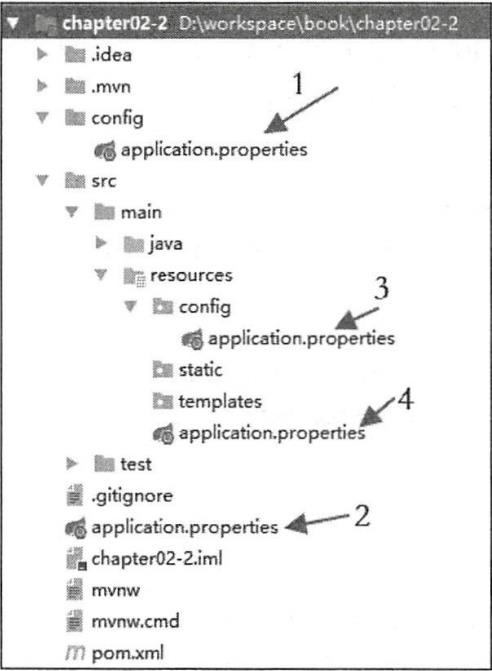
- 项目根目录下的config文件夹中。
- 项目根目录下。
- classpath 下的config文件夹中。
- classpath 下
application.yml配置文件的优先级与上面一致默认情况下, 如果开发者不想使用application.properties作为配置文件名,也可以自己定义。例如,在resources目录下创建一个配置文件app.properties,然后将项目打成jar包,打包成功后,使用如下命令运行:

2.6类型安全配置属性.
Spring提供了@Value注解以及EnvironmentAware接口来将Spring Environment中的数据注入到属性上, Spring Boot对此进一步提出了类型安全配置属性(Type-safe ConfigurationProperties) ,这样即使在数据量非常庞大的情况下,也可以更加方便地将配置文件中的数据注入Bean中.

yml类型配置文件:
my:
users:
- name: 江南一点雨
address: China
favorites:
- 足球
- 徒步
- Coding
- name: sang
address: GZ
favorites:
- 阅读
- 吉他
/**
* Created by sang on 2018/7/5.
*/
@Component
@ConfigurationProperties(prefix = "my")
public class Users {
private List<User> users;
}
2.7 YAML配置
YAML是JSON的超集,简洁而强大,是一种专门用来书写配置文件的语言,可以替代application.properties。在创建一个Spring Boot项目时,引入的spring-boot-starter-web依赖间接地引入了snakeyaml依赖, snakeyaml会实现对YAML配置的解析。YAML的使用非常简单,利用缩进来表示层级关系,并且大小写敏感。在Spring Boot项目中使用YAML只需要在resources目录下创建一个application.yml文件即可,然后向application.yml中添加配置:
server:
port: 80
servlet:
context-path: /chapter02
tomcat:
uri-encoding: utf-8
my:
users:
- name: 江南一点雨
address: China
favorites:
- 足球
- 徒步
- Coding
- name: sang
address: GZ
favorites:
- 阅读
- 吉他
2.8 Profile
开发者在项目发布之前,配置需要频繁更改,例如数据库配置、redis配置、mongodb配置、jms配置等。频·繁修改带来了巨大的工作量, Spring对此提供了解决方案(@Profile注解) , Spring Boot则更进一步提供了更加简洁的解决方案, Spring Boot中约定的不同环境下配置文件名称规则为application-{profile}.properties, profile占位符表示当前环境的名称,具体配置步骤如下:
不同的环境指定不同的配置文件
spring.profiles.active=dev

第3章Spring Boot整合视图层技术
Spring Boot官方推荐使用的模板引擎是Thymeleaf,不过像FreeMarker也支持, JSP技术在这里并不推荐使用。下面分别向读者介绍Spring Boot整合Thymeleaf和FreeMarker两种视图层技术。
3.1整合Thymeleaf
Thymeleaf是新一代Java模板引擎,类似于Velocity, FreeMarker等传统Java模板引擎。与传统Java模板引擎不同的是, Thymeleaf支持HTML原型,既可以让前端工程师在浏览器中直接打开查看样式,也可以让后端工程师结合真实数据查看显示效果。同时, Spring Boot提供了Thymeleaf自动化配置解决方案,因此在Spring Boot中使用Thymeleaf非常方便。Spring Boot整合Thymeleaf主要可通过如下步骤:
<dependency>
<groupId>org.springframework.boot</groupId>
<artifactId>spring-boot-starter-thymeleaf</artifactId>
</dependency>
2.配置Thymeleaf
Spring Boot为Thymeleaf提供了自动化配置类ThymeleafAutoConfiguration,相关的配置属性在ThymeleatProperties类中, ThymeleafProperties部分源码如下:
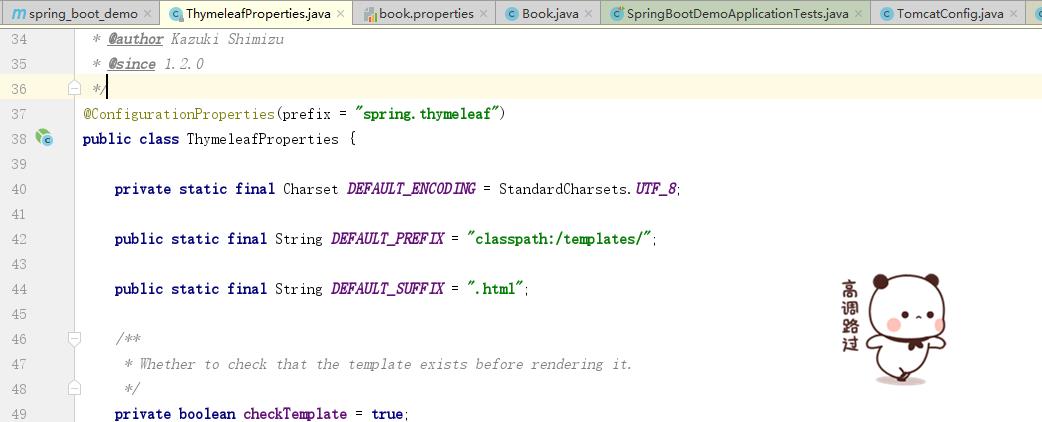
如果开发者想对默认的Thymeleaf配置参数进行自定义配置,那么可以直接在application.properties中进行配置,部分常见配置如下:
#是否开启缓存,开发时可设置为false,默认为true
spring.thymeleaf.cache=true
#是否检查模板是否存在,默认为true
spring.thymeleaf.check-template=true
#是否检查模板位置是否存在,默认为true
spring.thymeleaf.check-template-location=true
#模板文件编码
spring.thymeleaf.encoding=UTF-8
#模板文件位置
spring.thymeleaf.prefix=classpath:/templates/
#Content-Type配置
spring.thymeleaf.servlet.content-type=text/html
#模板文件后缀
spring.thymeleaf.suffix=.html
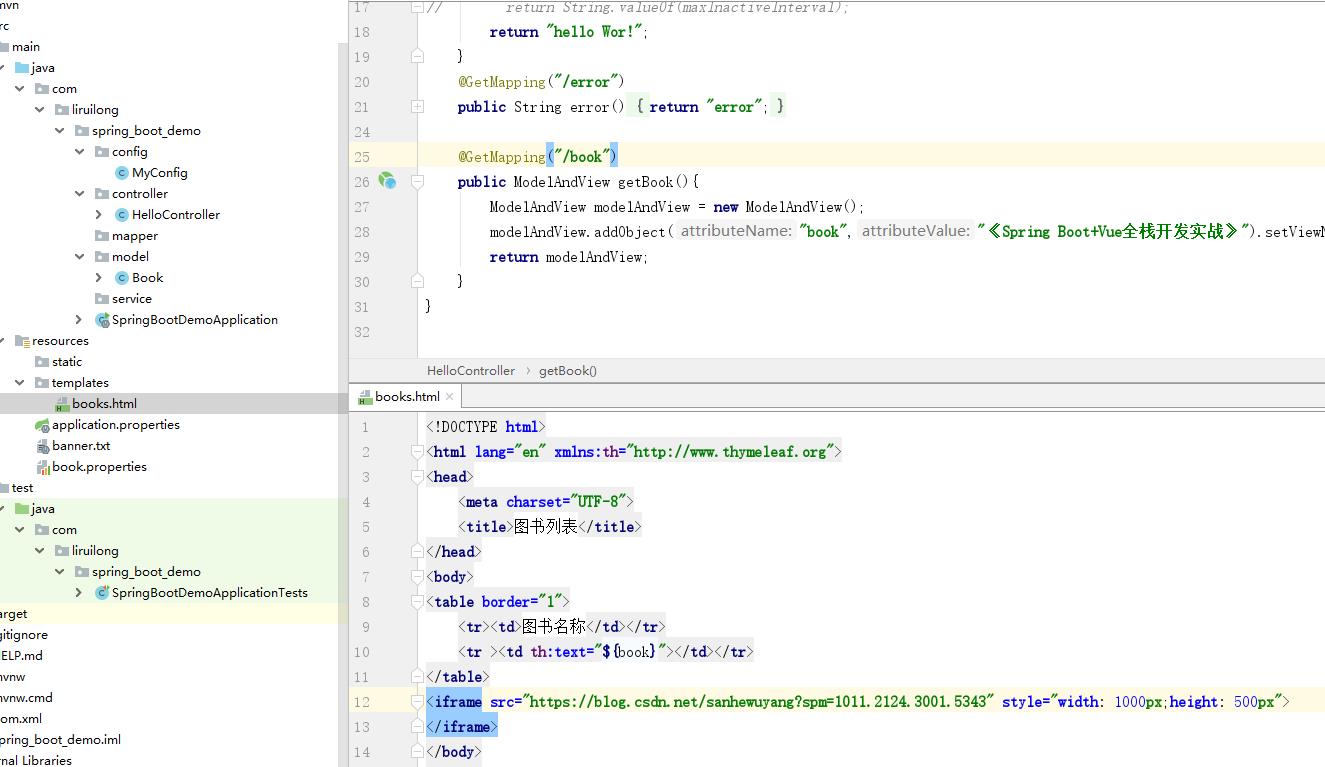
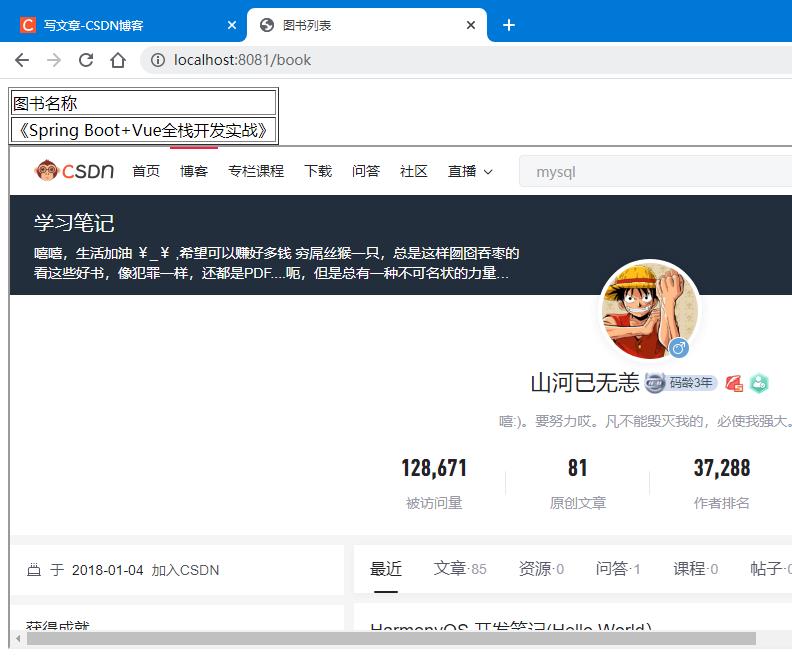
官网: https://www.thymeleaf.org
3.2整合FreeMarke
FreeMarker是一个非常古老的模板引擎,可以用在Web环境或者非Web环境中。与Thymeleaf不同, FreeMarker需要经过解析才能够在浏览器中展示出来。FreeMarker不仅可以用来配置HTML页面模板,也可以作为电子邮件模板、配置文件模板以及源码模板等。Spring Boot中对FreeMarker整合也提供了很好的支持.
配置FreeMarker
Spring Boot对FreeMarker也提供了自动化配置类FreeMarkerAutoConfiguration,相关的配置属性在FreeMarkerProperties 中,
#HttpServletRequest的属性是否可以覆盖controller中model的同名项
spring.freemarker.allow-request-override=false
#HttpSession的属性是否可以覆盖controller中model的同名项
spring.freemarker.allow-session-override=true
#是否开启缓存
spring.freemarker.cache=fal se
#模板文件编码
spring.freemarker.charset=UTF-8
#是否检查模板位置
spring.freemarker.check-template-location=true
#Content-Type的值
spring.freemarker.content-type=text/html
#是否将HttpServletRequest中的属性添加到Model中
spring.freemarker.expose-request-attributes=false
#是否将HttpSession中的属性添加到Model中
spring.freemarker.expose-session-attributes=true
#模板文件后缀
spring.freemarker.suffix=.ftl
#模板文件位置
spring.freemarker.template-loader-path=classpath:/templates/

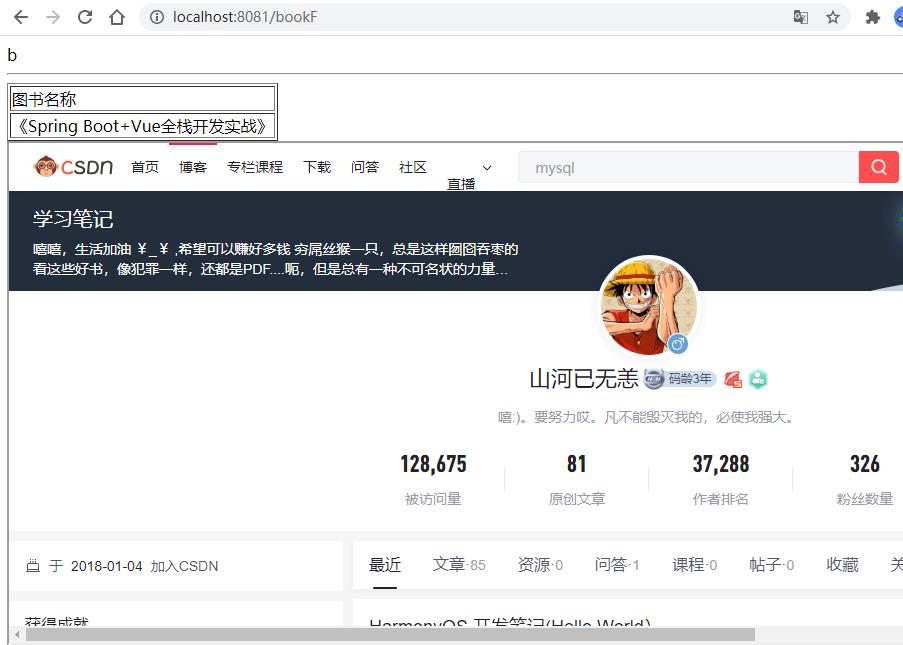
官网:https://freemarker.apache.org/
3.3 整合 JSP
<dependency>
<groupId>org.apache.tomcat.embed</groupId>
<artifactId>tomcat-embed-jasper</artifactId>
<scope>provided</scope>
</dependency>
<dependency>
<groupId>javax.servlet</groupId>
<artifactId>jstl</artifactId>
</dependency>
package com.liruilong.spring_boot_demo.config;
import org.springframework.context.annotation.Configuration;
import org.springframework.web.servlet.config.annotation.ViewResolverRegistry;
import org.springframework.web.servlet.config.annotation.WebMvcConfigurer;
/**
* @Classname WebMvcConfig
* @Description TODO
* @Date 2021/6/4 10:02
* @Created Li Ruilong
*/
@Configuration
public class WebMvcConfig implements WebMvcConfigurer {
@Override
public void configureViewResolvers(ViewResolverRegistry registry) {
registry.jsp("/WEB-INF/jsp/", ".jsp");
}
}
第4章 Spring Boot整合Web开发.
4.1返回JSON数据
4.1.1 默认实现
JSON是目前主流的前后端数据传输方式, Spring MVC中使用消息转换器HttpMessageConverter对JSON的转换提供了很好的支持,在Spring Boot中更进一步,对相关配置做了更进一步的简化。默认情况下,当开发者新创建一个Spring Boot项目后,添加Web依赖,
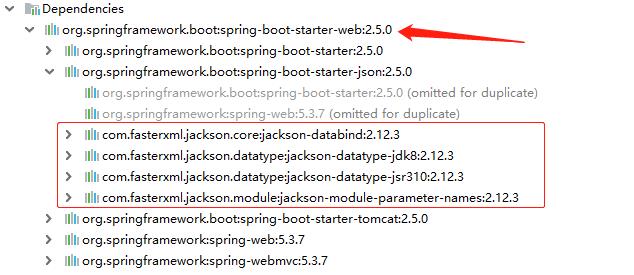
这个依赖中默认加入了jackson-databind作为JSON处理器,此时不需要添加额外的JSON处理器就能返回一段JSON了.
如果需要频繁地用到@ResponseBody注解,那么可以采用@RestController组合注解代替@Controller和@ResponseBody
这是Spring Boot自带的处理方式。如果采用这种方式,那么对于字段忽略、日期格式化等常见需求都可以通过注解来解决。这是通过Spring中默认提供的MappingJackson2HttpMessageConverter来实现的.
HttpMessageConverter ,看名字就知道,这是一个消息转换工具,有两方面的功能:
将服务端返回的对象序列化成 JSON 字符串将前端传来的 JSON 字符串反序列化成 Java 对象
所有的 JSON 生成都离不开相关的 HttpMessageConverter,SpringMVC 自动配置了Jackson 和 Gson 的 HttpMessageConverter,Spring Boot 中又对此做了自动化配置:org.springframework.boot.autoconfigure.http.JacksonHttpMessageConvertersConfigurationorg.springframework.boot.autoconfigure.http.GsonHttpMessageConvertersConfiguration
所以,如果用户使用 jackson 和 gson 的话,没有其他额外配置,则只需要添加依赖即可。
修改转化器
添加一个MappingJackson2HttpMessageConverter,由@ConditionalOnMissingBean确定。
嗯,我们温习一下条件化注解吧

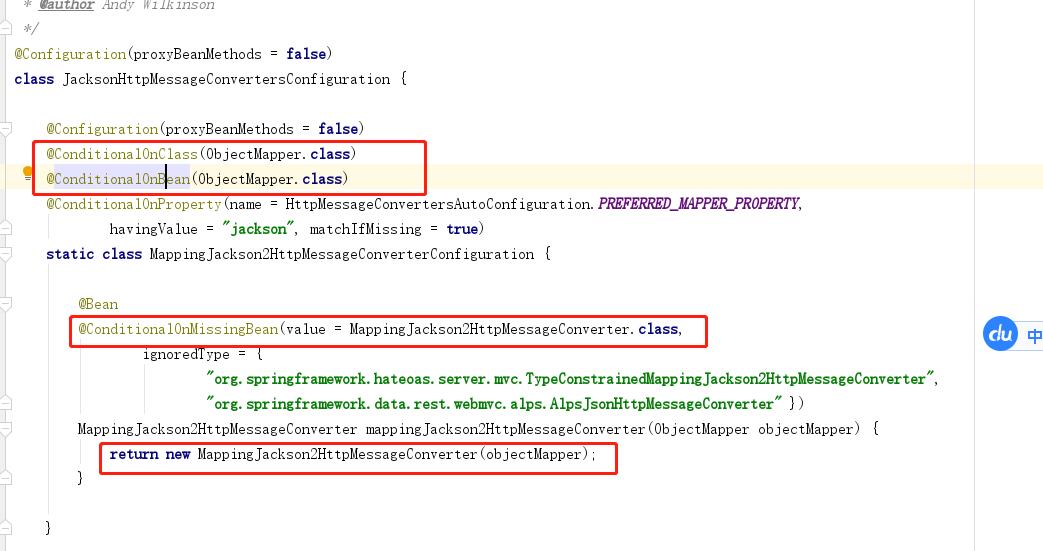

当然这里我们也可以只定义一个 ObjectMapper
package com.liruilong.spring_boot_demo.config;
import com.fasterxml.jackson.databind.ObjectMapper;
import org.springframework.context.annotation.Bean;
import org.springframework.context.annotation.Configuration;
import org.springframework.http.converter.json.MappingJackson2HttpMessageConverter;
import java.text.SimpleDateFormat;
/**
* @Classname WebMvcConfig
* @Description TODO
* @Date 2021/6/4 10:02
* @Created Li Ruilong
*/
@Configuration
public class WebMvcConfig {
@Bean
MappingJackson2HttpMessageConverter mappingJackson2CborHttpMessageConverter(){
return new MappingJackson2HttpMessageConverter(objectMapper());
}
@Bean
ObjectMapper objectMapper() {
ObjectMapper om = new ObjectMapper();
om.setDateFormat(new SimpleDateFormat("yyyy-MM-dd HH:mm:ss"));
return om;
}
}
4.1.2 自定义转换器
当然开发者在这里也可以根据实际需求自定义JSON转换器。常见的JSON处理器除了jackson-databind之外,还有Gson和fastison,这里针对常见用法分别举例.
Gson
Gson是Google的一个开源JSON解析框架。使用Gson,需要先除去默认的jackson-databind,然后加入Gson依赖
<dependency>
<groupId>org.springframework.boot</groupId>
<artifactId>spring-boot-starter-web</artifactId>
<exclusions>
<exclusion>
<groupId>org.springframework.boot</groupId>
<artifactId>spring-boot-starter-json</artifactId>
</exclusion>
</exclusions>
</dependency>
<dependency>
<groupId>以上是关于Vue + Spring Boot 项目实战笔记的主要内容,如果未能解决你的问题,请参考以下文章